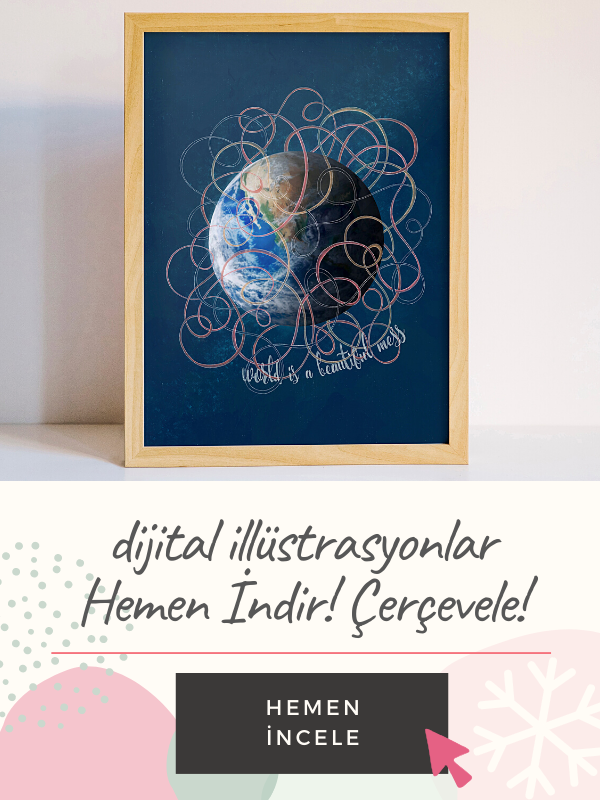Sevgili arkadaşım Sıla’nın Türkiye ziyaretinde gezmiş olduğu Atatürk Pavilyonu’na ait yazıyı aşağıda bulabilirsiniz. İyi okumalar,
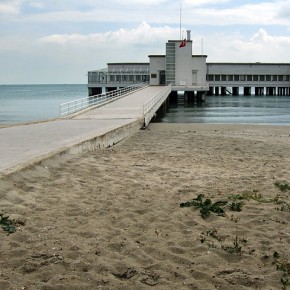
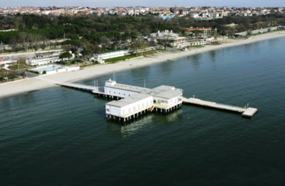
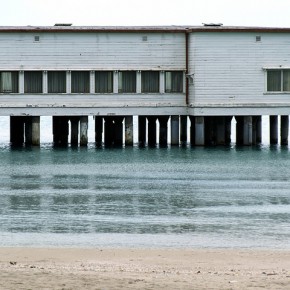
Dr. Neşet Ömer, Mustafa Kemal Atatürk’e hızla yayılan siroz hastalığını tedavi etmek ve etkilerini azaltmak için temiz hava ve deniz banyosu önerdiğinde modern Türkiye’nin kurucu babası nekahat dönemini İstanbul’un Avrupa Yakası’nda Marmara Denizi sahilinde bulunan Florya sahil beldesinde geçirmeye karar verdi. İsteği aslında lüks bir hapishane yerine insanlarla rahat iletişim içerisinde bulunabileceği bir dinlenme yeriydi.

Başkanin yazlık ev tasarımı için düzenlenen yarışmada yer alan tasarımcılardan ünlü Alman şehir planlamacısı Martin Wagner tasarım önerisini bir yerlesım bölgesinde şehir-bahçe (city-garden) teması ile düzenledi. Fakat yarışmayı Vedat Tek ve Giulia Mongeri’nin Güzel Sanatlar Akademisi’nde öğrencisi olan ve Berlin’de Hans Poelzing den aldigi eğitimi yeni bitirip ülkesine dönen Seyfi Arkan(1903-1966) çarpıcı beyaz tasarımı ile kazandı. Su üzerine yerleştirilmiş bu beyaz modern köşk genç Türkiye’nin batinin gelişmiş demokratik durumuna uyumunu ve 20. yüzyıldaki bu uyum sürecininde ilerleme arzusunu da ifade ediyordu. Tamamen ahşap olarak yapılan bina 43 günlük rekor bir sürede inşa edildi(1935).
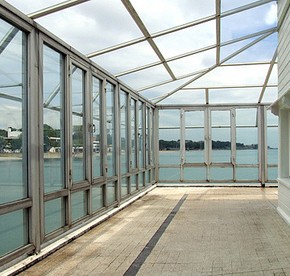
Florya Atatürk Köşkü, 1930lu yılların kompozit modernizm üslup özellikleri, kazıklar (pilotis), düz çatı, uzunlamasına çalışan pencereler, Le Corbusier’in ev-vapur (house-streamship) ütopyasina uygunluğu, Bauhaus’un doğal mekana uzanan net plan anlayışı ile 19. yüzyıl boyunca kazık konutlar üzerinde inşa edilen Osmanlı deniz odalarının bir birleşimiydi.
Ayni seviyede inşa edilen iki çizgisel yapı dik açılı olarak kesişmektedir.Köşkün kıyıya dik kanadında servis, personel odaları, banyo ve tuvaletler; doğu kanadı boyunca uzanan bölümünde ise Atatürk’ün calışma odası, yatak odası, banyosu ve kabul salonu yer alır.
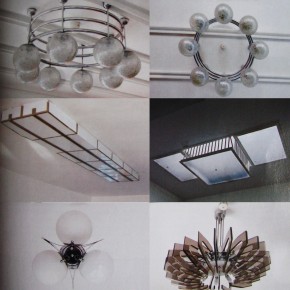
Yalın mimari stiline karsı, özel tasarlanmış çatı pencereleri,aydınlatma elemanları ve tavan seçiminde art-deco etkileri görülmektedir.
Mustafa Kemal Atatürk hayatinin son tatil dönemini tüm evlatlık çocukları ile birlikte bu beyaz köşkte, zamanını yüzerek, kano yaparak ve diplomatik toplantılarına devam ederek geçirmiştir. 1938 yılında ölümünden sonra, sahil köşk 1988 yılına kadar Türkiye devlet başkanlarının yazlık evi, 1988 den sonra ise müze olarak kullanılmaktadır.
——–
When Dr. Neset Omer prescribed fresh air and bathing in the sea to Mustafa Kemal Ataturk to try and slow down the rapidly spreading liver ailment that was afflicting him, the legendary founding father of modern Turkey elected to spend his convalescence periods in the popular seaside resort of Florya, along the European coast of the Marmara Sea, just outside Istanbul. Somewhere to escape the luxurious confinement of power and replace the hagiography of the legendary and intangible leader with the democratic epic of the statesman close to the people. The famous German town-planner Martin Wagner was one of those who took part in the closed competition to design the president’s summer home, proposing a residential district set out like a city-garden. But it was Abdurrahman SeyfiArkan (1903-1966), a former pupil of Vedat Tek and Giulio Mongeri at the Fine Arts Academy in Istanbul just home from taking a refresher course with Hans Poelzig in Berlin, who actually won the competition with his striking white pavilion on water symbolically embodying (by instrumentally drawing on the linguistic repertoire of the European avant-gardes) the new values of progressive nationalism that aimed to take the country into the 20th century and the assembly of advanced western democracies. Built entirely out of wood and completed in the record time of 43 working dap, Florya’s Ataturk Köşkü manages to combine the styllistic features of 1930s’ cosmopolitan modernism – pilotis, flat roof, window running lengthwise, LeCorbusier’s utop ia of the house-steamship, Bauhaus-style open layout projected into natural space – with underlying reminiscences of traditional 19th-century Ottoman bathing resorts constructed each season around pile dwellings, pieds dans l’eau. Two linear constructions built over one single level, intersecting at a right-angle, respectively house the utility rooms and staff quarters (the construction set perpendicular to the lido), with the guest rooms, Ataturk’s private study and a large reception chamber, surrounded by a glass veranda with a second strip- shaped pier projecting out towards the sea located in the other construction parallel to the shore.
Here, against the backdrop of stylised clear walnut wooden panelling and a varied selection of valuable custom-designed skylights, lamps and ceiling lights, still imbued with deco influences, the “Father of the Turks” spent the last holidays of his life, dividing his time between swimming, canoeing and international diplomatic meetings, lavished with the attentions of the adoring crowds and all his adopted children. After his death in 1938, the seaside pavilion was used as a private summer home for Turkish heads of State until 1988, when it became a museum to itself.
—-
Nel 1935, quando il Dott. Neset Omer prescrisse a Mustafa Kemal Ataturk aria buona e bagni di mare per alleviare il rapido decorso della malattia epatica che lo affliggeva, il padre della patria e fondatore della Turchia moderna, elesse meta dei propri periodi di riposo e villeggiatura la popolare localita’ balneare di Florya, sulla costa europea del Mar di Marmara, subito fuori Istanbul. Un luogo dove evadere dal confinamento dorato del potere e surrogare I’agiografia del condottiero mitico e intangibile con I’epopea democratica dello statista vicino alla gente. Al concorso ristretto indetto per la progettazione dell’abitazione estiva del presidente partecipio anche l’illustre urbanista tedesco Martin Wagner con la proposta di un comprensorio residenziale organizzato come una citta-giardino. Vincitore fu decretato pero’ il giovane architetto Abdurrahman Seyfi Arkan (1903-1966), gia allievo di Vedat Tek e Giulio Mongeri all’Accademia di Belle Arti di Istanbul e fresco reduce da un’esperienza di aggiornamento con Hans Poelzig a Berlino, grazie all’immagine icastica di un candido padiglione sull’acqua che incarnava simbolicamente, nel ricorso strumentale al repertorio linguistico dell’avanguardia europea, i nuovi valori di un nazionalismo progressista che si prefiggeva di veicolare il paese nel XX secolo e nel consenso delle democrazie occidentali avanzate.
Costruito interamente in legno e completato a tempo di record in 43 giorni di lavoro, l’Ataturk Kosku di Florya é una struttura che coniuga gli stilemi del modernismo cosmopolita anni Trenta – pilotis, tetto piano, finestra in lunghezza, I’utopia lecorbusieriana della casa-piroscafo, la pianta aperta, protesa nello spazio naturale, del Bauhaus – con sottaciute reminiscenze della tradizione ottocentesca degli stabilimenti balneari ottomani, approntati su palafitte, pieds dans l’eau, con ciclicita stagionale. Due corpi in linea su un solo livedo, intersecati ad angolo retto, ospitano rispettivamente I locali di servizio e gli alloggi per il personale, quello perpendicolare al lido; le camere per gli ospiti, lo studio privato di Ataturk e una grande sala di ricevimento, contornata da una veranda di vetro dalla quale fuoriesce, proiettandosi verso il mare aperto, un secondo molo nastriforme, quello parallelo all’arenile. Qui, sullo sfondo di stilizzate boiserie di radica dorata e di un assortito campionario di preziosi lampadari, plafoniere e lucernari su disegno, ancora intrisi di influenze deco, Mustafa Kemal Ataturk trascorse le ultime vacanze della sua vita, dividendosi fra nuotate, escursioni in canoa e incontri diplomatici internazionali, circondato dall’affetto della folia e dei tanti figli adottivi. Dopo la sua morte, awenuta nel 1938, il padiglione marittimo e stato utilizzato come dimora estiva privata dai capi di Stato turchi fino al 1988, quando e diventato museo di se stesso.
- Yazan: Sıla Giriftinoğlu (twitter.com/silagr)
- Editör: Zeynep Yılmaz

